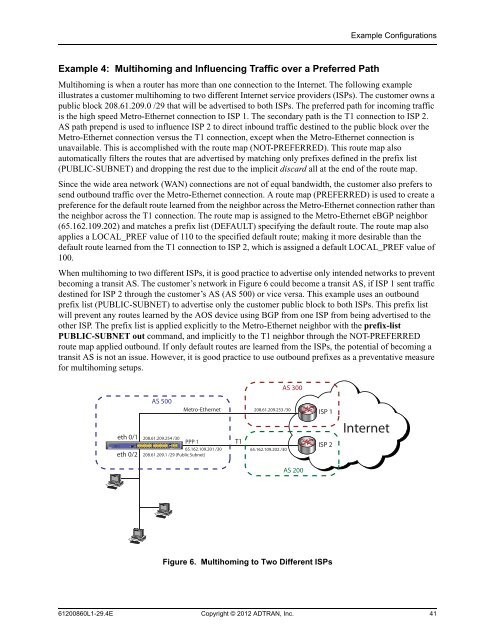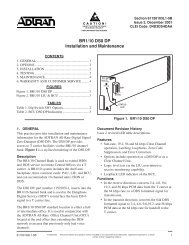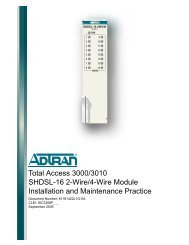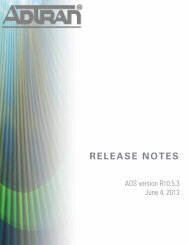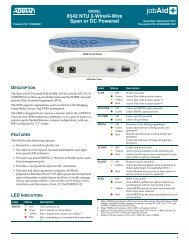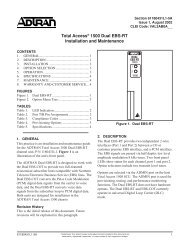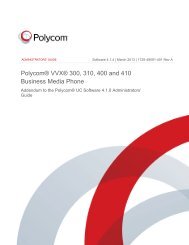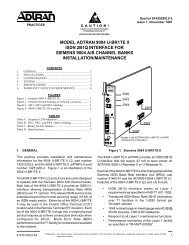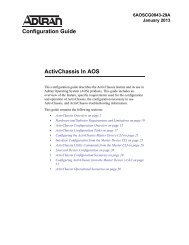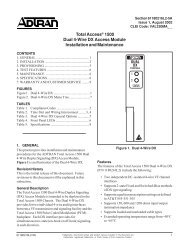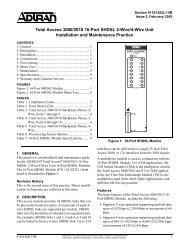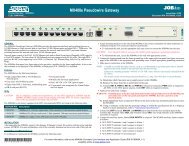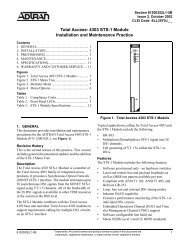View - ADTRAN Support Community
View - ADTRAN Support Community
View - ADTRAN Support Community
You also want an ePaper? Increase the reach of your titles
YUMPU automatically turns print PDFs into web optimized ePapers that Google loves.
NetVanta 1234<br />
STAT<br />
1 5 9 13 17 21 G1<br />
2 6 10 14 18 22 G2<br />
3 7 11 15 19 23 G3<br />
4 8 12 16 20 24 G4<br />
1 3 5 7 9 11 13 15 17 19 21 23<br />
2 4 6 8 10 12 14 16 18 20 22 24<br />
G1<br />
G2<br />
G3<br />
G4<br />
Example Configurations<br />
Example 4: Multihoming and Influencing Traffic over a Preferred Path<br />
Multihoming is when a router has more than one connection to the Internet. The following example<br />
illustrates a customer multihoming to two different Internet service providers (ISPs). The customer owns a<br />
public block 208.61.209.0 /29 that will be advertised to both ISPs. The preferred path for incoming traffic<br />
is the high speed Metro-Ethernet connection to ISP 1. The secondary path is the T1 connection to ISP 2.<br />
AS path prepend is used to influence ISP 2 to direct inbound traffic destined to the public block over the<br />
Metro-Ethernet connection versus the T1 connection, except when the Metro-Ethernet connection is<br />
unavailable. This is accomplished with the route map (NOT-PREFERRED). This route map also<br />
automatically filters the routes that are advertised by matching only prefixes defined in the prefix list<br />
(PUBLIC-SUBNET) and dropping the rest due to the implicit discard all at the end of the route map.<br />
Since the wide area network (WAN) connections are not of equal bandwidth, the customer also prefers to<br />
send outbound traffic over the Metro-Ethernet connection. A route map (PREFERRED) is used to create a<br />
preference for the default route learned from the neighbor across the Metro-Ethernet connection rather than<br />
the neighbor across the T1 connection. The route map is assigned to the Metro-Ethernet eBGP neighbor<br />
(65.162.109.202) and matches a prefix list (DEFAULT) specifying the default route. The route map also<br />
applies a LOCAL_PREF value of 110 to the specified default route; making it more desirable than the<br />
default route learned from the T1 connection to ISP 2, which is assigned a default LOCAL_PREF value of<br />
100.<br />
When multihoming to two different ISPs, it is good practice to advertise only intended networks to prevent<br />
becoming a transit AS. The customer’s network in Figure 6 could become a transit AS, if ISP 1 sent traffic<br />
destined for ISP 2 through the customer’s AS (AS 500) or vice versa. This example uses an outbound<br />
prefix list (PUBLIC-SUBNET) to advertise only the customer public block to both ISPs. This prefix list<br />
will prevent any routes learned by the AOS device using BGP from one ISP from being advertised to the<br />
other ISP. The prefix list is applied explicitly to the Metro-Ethernet neighbor with the prefix-list<br />
PUBLIC-SUBNET out command, and implicitly to the T1 neighbor through the NOT-PREFERRED<br />
route map applied outbound. If only default routes are learned from the ISPs, the potential of becoming a<br />
transit AS is not an issue. However, it is good practice to use outbound prefixes as a preventative measure<br />
for multihoming setups.<br />
AS 300<br />
eth 0/1<br />
eth 0/2<br />
AS 500<br />
Metro-Ethernet<br />
208.61.209.254 /30<br />
PPP 1<br />
T1<br />
208.61.209.253 /30<br />
65.162.109.201 /30 65.162.109.202 /30<br />
208.61.209.1 /29 (Public Subnet)<br />
AS 200<br />
ISP 1<br />
ISP 2<br />
Internet<br />
Figure 6. Multihoming to Two Different ISPs<br />
61200860L1-29.4E Copyright © 2012 <strong>ADTRAN</strong>, Inc. 41


